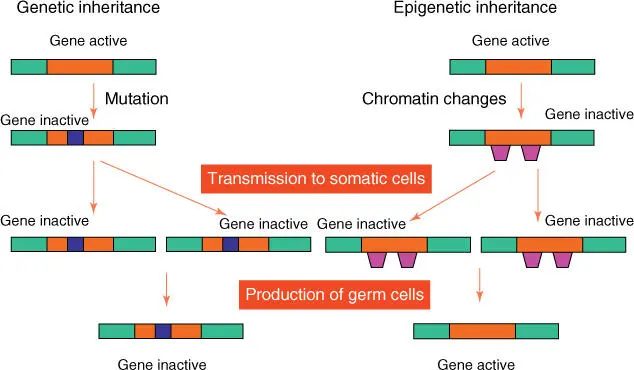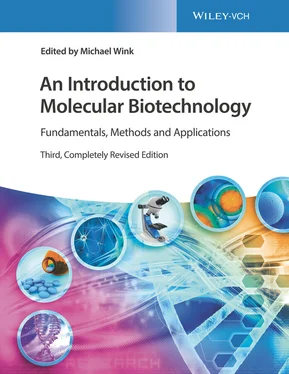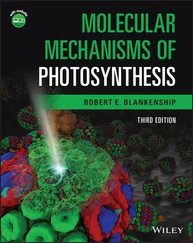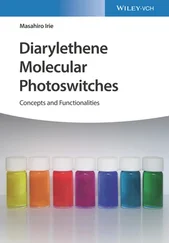Control of gene expression in eukaryotes is very complex. In eukaryotic genomes, there are considerably more genes present than proteins required for a single cell. Therefore, it is necessary to express genes in a cell‐, tissue‐, and development‐specific fashion. This means that out of the estimated 21 000 genes encoding proteins in humans and 9000 noncoding RNA genes, only 30–60% are activated in individual differentiated cells. Research and documentation of differential gene expression patterns is part of the enormous task for current molecular biology. Presently, a new technique, such as RNA‐seq, has been sort of revolution for transcriptomics( Chapter 21).
The transcriptionof eukaryotic genes ( Figure 4.17b) is controlled by neighboring regulatory DNAregions ( promoter regions) that are themselves controlled by transcription regulators, which are responsible for the activation or inactivation of a gene. As well as the promoter region that is in close proximity to the coding sequences, further cis‐regulatory elements ( enhancer, silencer) can also be positioned further away ( Figure 4.17b). The eukaryotic RNA polymerase II is only activated when diverse transcription factors/regulators have bound to the promoter ( Figure 4.17b). Table 4.6reviews the most important control elements and the associated consensus sequences.
Table 4.6 Consensus sequences in eukaryotic promoter regions.
| Box |
Consensus sequence |
Transcription factor |
| BRE |
G/C G/C G/A C G C C |
TFIIB |
| TATA |
T A T A A/T A/A/T |
TBP |
| INR |
C/T C/T A N T/A C/T C/T |
TFIID |
| DPE |
A/G G A/T C G T G |
TFIID |
As most genes in eukaryotic cells are expressed in a cell‐, tissue‐, and development‐specific manner, additional specific transcription regulators play a decisive role. Very many of these factors have not yet been discovered. Apparently, transcription regulators do not work alone but together in complex networks, which include not only transcription factors but also modifications at the DNA (methylation) and chromatin (histone modifications) level. Transcription can also be controlled by various other effectors, such as small noncoding RNAs, lncRNAs, miRNAs, and siRNAs, but also by the speed of RNA transport and degradation.
As opposed to bacteria, eukaryotic protein‐coding genes usually consist of exons (expressed sequences )and introns (intervening sequences )( Figure 4.18) and are therefore referred to as mosaic genes. Exons often encode protein domains; it has been suggested that the exon/intron arrangement has facilitated the emergence of new genes during evolution: In a “modern” gene, exons from several genes have been combined from earlier smaller existing genes.

Figure 4.18 Structure of a eukaryotic gene. NCS, noncoding sequence.
The primary transcript deriving from the transcription is completely processed in the nucleus. It is spliced in a multienzyme complex, the spliceosome, so that each noncoding intron region, which is flanked by GU and AG sequences, is removed. snRNAsare catalytically involved in splicing. The snRNA can be seen as a type of ribozyme(see Section 2.4). In eukaryotes, differentialor alternative splicingof the genes is a common theme ( Figure 4.19). That is, not all exons will be present in the final mRNA. Due to alternative splicing, a single gene can lead to more proteins (isoforms) depending on the tissue in which they are expressed (this is the reason why the number of proteins in humans is several times higher than the number of genes).

Figure 4.19 Schematic representation of alternative splicing processes. The letters A, B, C, and so on indicate exons. After the complete primary transcript is produced, further selection occurs in the splicing process, in which not all exons remain but a few are removed with the introns. In this way, many different proteins are synthesized from one gene, which differ in domain composition. NCS, noncoding sequence.
The assignment of template or coding strand does not apply for a complete chromosome; the orientationwithin chromosomes can change from gene to gene, meaning that gene A can be read from the template strand and the neighboring gene B from the strand lying opposite. In eukaryotes, the genes are arranged in a linear manner, one after the other, on chromosomes. In prokaryotes, overlapping genes are found, which are coded for either by the same DNA strand or the complementary DNA strand lying opposite. This results in more dense information but prevents the independent evolution of the DNA sequences.
For the position of the consensus boxes see Figure 4.17.
In eukaryotes, the mRNA is further modified by the addition of a cap structure (to the nascent RNA molecule) at the 5′‐end and a poly(A) tailat the 3′‐end ( Figure 4.15). The poly(A) polymerase, which does not require a template, adds around 200 A nucleotides to the 3′‐end. The fully processed mRNA is complexed by several proteins (poly(A)‐binding proteins, nuclear export receptor, hnRNP proteins, CBC, and SR proteins). The mRNA–protein complex is recognized by the nuclear pore complex(NPC) and transported into the cytoplasm (see Chapter 5). Damaged RNA molecules are degraded in the nucleus by the exosome.
In gene regulation, the methylation of cytosine( 5‐methylcytosinein plants and animals) and adenine( N 6 ‐methyladeninein prokaryotes) also plays an important role. As a rule, genes that are transcribed are less methylated than genes that are turned off ( silent). After each replication, the methylation of the newly replicated DNA strands must take place; an inhibition of the corresponding methyl transferasesstrongly influences gene expression and cell differentiation. DNA methylation is also important for DNA repair, being that the repair enzymes can recognize a newly constructed and defective DNA strand by the absence of methylation. Methylation and changes in chromatin structure change the expression patterns of genes; these changes are inherited to daughter cells (so‐called genomic imprintingor epigenetic inheritance) ( Figure 4.20). Usually, epigenetic changes are not transferred (this is an open debate at present) via the germline to the next generation, whereas mutations in gametes are inherited.

Figure 4.20 Differences between genetic and epigenetic inheritance.
The nucleotide sequence of mRNA is translated using the genetic codeinto amino acid sequences. tRNA, with its specific anticodon, serves as a mediator between the mRNA and the protein. A central event in the progress in molecular biology was the discovery of the unit‐less, comma‐less, nonoverlapping code in all living organisms. In each case, three nucleotides code for a specific amino acid in each protein (Table 2.4). Using a triplet code with four bases, there are 4 3= 64 available combinations. As there are only 20 amino acids that are used to synthesize proteins (Table 2.4), there are more codons than are actually necessary. This problem was solved by evolution in such a way that most of the amino acids are not be coded from only one, but from two to at the most six different synonymous codons(Table 2.4).
Читать дальше






![Andrew Radford - Linguistics An Introduction [Second Edition]](/books/397851/andrew-radford-linguistics-an-introduction-second-thumb.webp)








